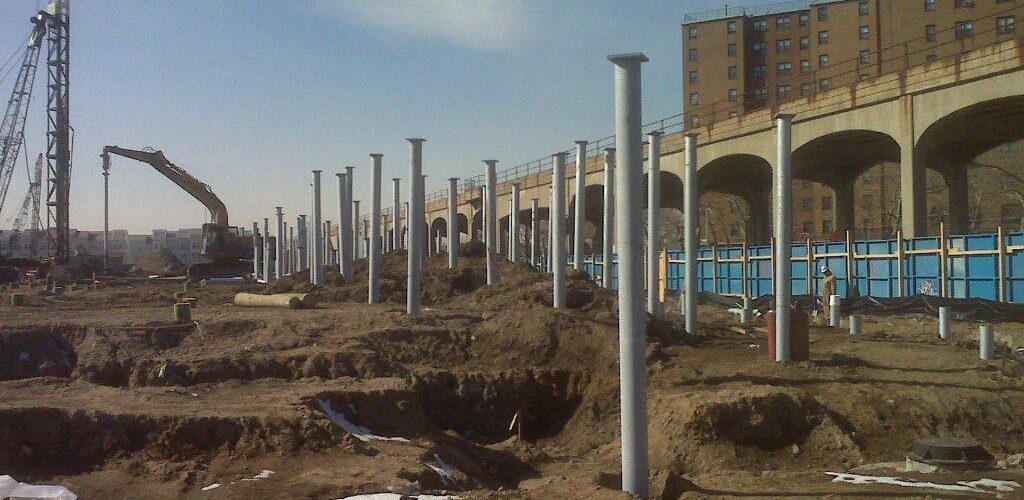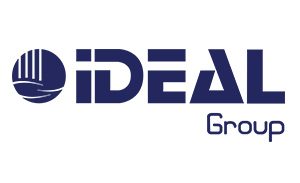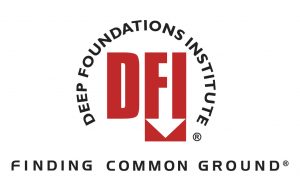Approximately twenty years ago, I first learned about efforts to get helicals approved for use in Los Angeles. Long delayed due to seismic concerns, it finally happened! Helicals were recently approved for certain uses in LA. Hallelujah! But in a state that prides itself on technological and environmental innovation, what took so long?
Click here to read Helical piles – LABC supplement conditions v1.1 (helicalpileworld.com)
We experienced similar frustration in our territory in the Northeast/Mid-Atlantic region. We did not get approval to use helicals in New York City until 2008 and, when it came, it came with required load tests, or a higher factor of safety, minimum pile diameter, and other stipulations. What makes code approvals in congested, over-built, big cities particularly interesting is that helicals are a wonderful foundation tool to deal with all the site restrictions and other issues associated with urban environments. This article, with links to case study examples, lays out some of the work we have performed and the reasons helicals got the nod over other foundation elements. All these installations illustrate why helicals are an inspired, IDEAL choice in metropolitan areas, eliminating or mitigating access, mobilization, vibration, and contaminated urban fill soils.
Mobilization and Access
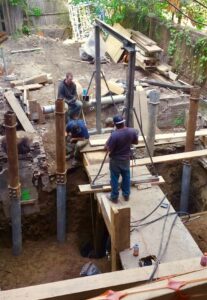 Small installation equipment, allowing for work in tight confined spaces, is huge when working in a city. A machine and drive string assembly that can install the piles as quickly and efficiently as possible is preferred. However, that is not always possible, and ingenuity is often necessary as it was behind a Greenwich Village townhouse. There was no way to get a machine back to the rear of the property, so a portable hand-held unit, powered by a machine staged out front in the street, was used to install the piles. Click here to read West 11th Street Manhattan Case Study
Small installation equipment, allowing for work in tight confined spaces, is huge when working in a city. A machine and drive string assembly that can install the piles as quickly and efficiently as possible is preferred. However, that is not always possible, and ingenuity is often necessary as it was behind a Greenwich Village townhouse. There was no way to get a machine back to the rear of the property, so a portable hand-held unit, powered by a machine staged out front in the street, was used to install the piles. Click here to read West 11th Street Manhattan Case Study
Hand-held is slow and requires strict safety precautions, but sometimes it is your only option, as it was at this Hoboken, NJ townhouse. Click here to read Hoboken NJ Townhouse Emergency Repair Case Study
Interior work is always tough regardless of where the project is located as it was with these projects in Brooklyn and Philadelphia. However, in both cases, there was enough room to use a machine.
Click here to read Amanda Moffat Pottery Brooklyn NY Case Study
Click here to read The Battery Philadelphia PA Case Study
The historic Lillian Wald Houses in the lower east side of Manhattan and a Brooklyn warehouse are other examples of access limitations driving the decision to use helicals.
Click here to read Lillian Wald Houses Case Study
Click here to read 1109 Metropolitan Ave Brooklyn Warehouse Case Study
No Vibration
Vibration concerns are an important factor in the above cited projects and are frequently an issue with the close proximity of older buildings with suspect foundations. This was the case with the 20th Street townhouses and Taco Bell in Philadelphia.
Click here to read 3310 20th Street Philadelphia PA Townhouses Case Study
Click here to read Taco Bell KFC Case Study
Soil Conditions
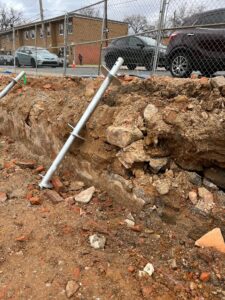 Taco Bell and 20th Street in Philadelphia, PA also illustrate another reason helicals are selected over other foundation elements in cities: soil conditions. Urban fill and/or contaminated soil issues are mitigated or completely eliminated as helical piers require little, to no, excavation or safe soil disposal. In addition, the screwed-in installation methodology of helical piles can often fight their way through urban debris. If necessary, installers can also pre-drill through the fill layer before installing the piles. The owner of 12th and Girard in Philadelphia saved a bundle, eliminating over-excavation and the removal of contaminated soils, by using helicals.
Taco Bell and 20th Street in Philadelphia, PA also illustrate another reason helicals are selected over other foundation elements in cities: soil conditions. Urban fill and/or contaminated soil issues are mitigated or completely eliminated as helical piers require little, to no, excavation or safe soil disposal. In addition, the screwed-in installation methodology of helical piles can often fight their way through urban debris. If necessary, installers can also pre-drill through the fill layer before installing the piles. The owner of 12th and Girard in Philadelphia saved a bundle, eliminating over-excavation and the removal of contaminated soils, by using helicals.
Click here to read 12th Street and Girard Avenue Philadelphia PA Case Study
On other occasions, we have used the grouted helical micropile to isolate the steel from known contaminants while gaining increased capacity from the grout columns to form a larger diameter pile. This was the case at Tasker Homes in Philadelphia, PA. At the time, that project represented the largest housing project in the world completely supported on Grouted Helical Micropiles. A similar situation existed when we worked for the National Guard at the Atlantic City Armory in New Jersey.
Click here to read Tasker Homes A Turning Point For The Grouted Helical Micropile Case Study
Click here to read Atlantic City NJ Armory Case Study
Municipal Infrastructure
In major cities, helicals are very valuable for municipal infrastructure projects because of their ability to address all of the site conditions already described.
Click here to read Meadowmere Sewer Reconstruction Queens NY Case Study
Click here to read Northeast Water Pollution Control Plant Philadelphia PA Case Study
Click here to read Poplar Point Duct Bank Washington DC Case Study
Click here to read Poplar Point Manhole Sewer Piles Washington DC Case Study
Click here to read Poplar Point Pump Station Washington DC Case Study
Special Circumstances
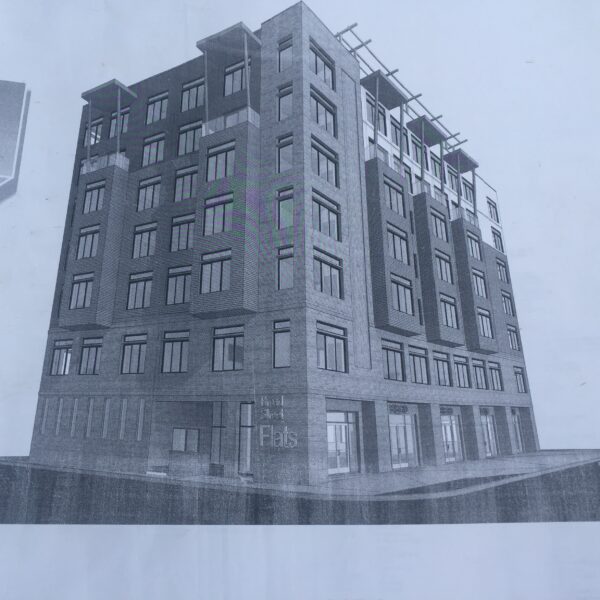 Sometimes projects in urban environments bring their own unique issues that require special considerations before a project is approved. Both the Stop & Shop Supermarket in Queens, NY and 701 Broad Street in Philadelphia, PA were adjacent to subways, which raised vibration concerns. These concerns were eliminated when the original foundations were converted to gently screwed-in helicals.
Sometimes projects in urban environments bring their own unique issues that require special considerations before a project is approved. Both the Stop & Shop Supermarket in Queens, NY and 701 Broad Street in Philadelphia, PA were adjacent to subways, which raised vibration concerns. These concerns were eliminated when the original foundations were converted to gently screwed-in helicals.
Click here to read Stop and Shop Arverne NY Case Study
Click here to read 701 Broad Street Philadelphia PA Case Study
Perfect Together
As these numerous projects show, helicals and metropolitan construction are made for one another. The elimination or mitigation of thorny site issues such as mobilization, access, no vibration, contaminated soils, urban fill, and other unique circumstances make helicals a natural fit for urban environments. Welcome aboard, LA! It won’t be long before owners, builders, engineers, architects, and city code officials will be wondering why they didn’t hop on the happy helical train much sooner.


